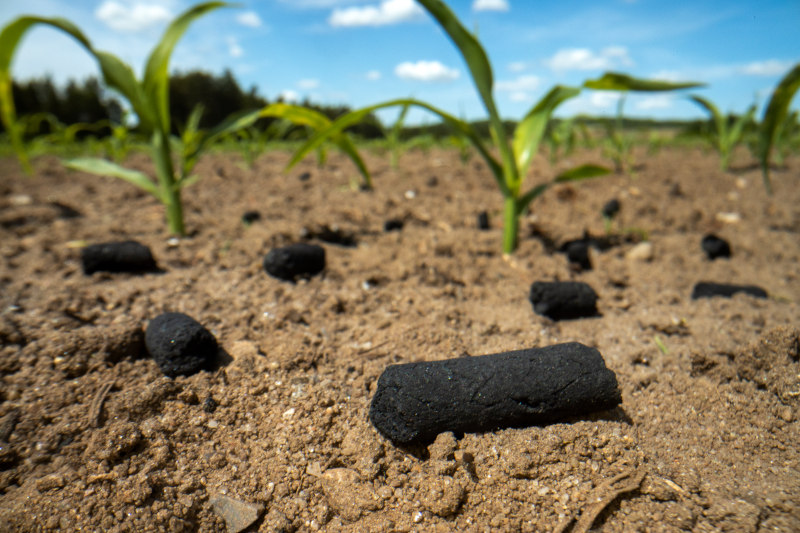
-
Is pyrolysis a mature technology?
Pyrolysis is a technology that has been used for millennia to produce biochar, specifically charcoal.
In 2021, according to the FAO’s statistical yearbook, just over 53 million tons of charcoal were produced through pyrolysis. The majority of this charcoal is used as fuel, but there is theoretically no impediment to using it for carbon storage.
The current annual production of charcoal and biochar corresponds to the capture and storage of over 100 million tons of CO2.
The production of biochar through pyrolysis specifically for capturing and storing CO2 from the atmosphere is not new. Currently, up to 20 European and American companies offer complete solutions in this field.
At the end of 2023, certificates had been issued globally for a total of approximately 110,000 tons of CO2 captured and stored from the atmosphere using Carbon Dioxide Removal (CDR) technologies.
Of this, biochar accounts for about 100,000 tons, while the sum of capture and storage from all other known CDR technologies accounts for about 10,000 tons. Biochar produced through pyrolysis is thus the most tested and mature technology for capturing and storing carbon from the atmosphere. Pyrolysis is also the most scalable technology, at least in the short to medium term.
In light of this, pyrolysis must be regarded as a mature technology.
-
How much CO2 can be removed from the atmosphere through pyrolysis?
Pyrolysis of straw stores approximately 0.7 million tons of CO2 per million tons of dry matter as biochar. This is accompanied by a displacement of about 0.45 million tons of CO2 by replacing fossil fuels with green fuels, totaling about 1.15 million tons of CO2 stored and displaced per million tons of dry matter.
Pyrolysis of waste from biogas plants stores approximately 0.75 million tons of CO2 per million tons of dry matter as biochar. Additionally, there is a displacement of about 0.3 million tons of CO2 by replacing fossil fuels with green fuels and saved methane emissions equivalent to about 0.1 million tons of CO2. Here too, the total is approximately 1.15 million tons of CO2 stored and displaced per million tons of dry matter.
A useful, slightly conservative rule of thumb is that one million tons of CO2 is captured or displaced per million tons of dry matter feedstock.
-
Can pyrolysis form heavy metals?
No new elements, including heavy metals, can be formed by pyrolysis.
When returning biochar produced from crop residues to a farm, no additional or more heavy metals are introduced to the farmland than would have been added by mulching crop residues without prior conversion to stable biochar.
-
Can pyrolysis of agricultural residues form other pollutants?
Yes, other pollutants can be formed by pyrolysis of agricultural residues, and active process control is necessary to ensure that the levels of such pollutants remain below all relevant threshold values.
Stiesdal SkyClean and other companies in Europe and the USA producing biochar to capture and store CO2 have no issues implementing the necessary process control for certification of sufficient purity in the biochar.
Numerous analyses conducted by independent laboratories have demonstrated that the content of pollutants in biochar from Stiesdal’s SkyClean plant is far below all relevant limits for products that can be distributed in agriculture.
SkyClean biochar also meets the limits for the constituents in fertilizers.
-
Is pyrolysis a highly energy-intensive process?
The pyrolysis process in a SkyClean plant utilizes approximately 5% of the energy content in the biomass used to drive the process.
The remaining energy content in the biomass is preserved in the two products from the plant, biochar, and biofuel.
In light of this, pyrolysis cannot be considered a highly energy-intensive process.
-
Is biochar stable when distributed on agricultural soil, or does it release the captured CO2 rapidly?
The stability of biochar, when applied to agricultural soil, depends on factors like the type of biomass, pyrolysis method, pyrolysis temperature, and the temperature of the soil where the biochar is stored.
Biochar from Stiesdal’s SkyClean pyrolysis is produced at a process temperature of 600°C.
The IPCC estimates that the average carbon retention for biochar produced at 600°C will be at least 89% after one hundred years at a soil temperature of 20°C.
The IPCC states that this assessment is conservative, as the breakdown of biochar increases with soil temperature, and the global average soil temperature is estimated to be around 10°C. In Denmark, the average soil temperature is approximately 8°C, which would result in a retention rate well above 90%.
Additionally, biochar produced by so-called slow pyrolysis, such as that from Stiesdal’s SkyClean process, has a particularly low hydrogen content, further extending its lifespan.
Researchers from Aarhus University have recently published observations of the microstructure of biochar from Stiesdal’s SkyClean plant, showing that the biochar has the same microstructure as coal stored in geological formations for 10,000 years.
The stability of biochar produced through high-temperature pyrolysis for carbon storage meets the requirements for “permanent carbon storage” in the EU’s CRCF directive, defined as a carbon removal activity that, under normal circumstances and using appropriate management practices, stores atmospheric or biogenic carbon for several centuries.
-
Could the same climate benefits be acquired by simply mulching the agricultural residues?
When mulching straw, it is estimated that about 25% of the carbon content remains after 2 years. After 20 years, approximately 7.5% is left, and after one hundred years, around 3%.
In comparison, over 90% of the carbon is preserved in biochar produced by the Stiesdal SkyClean process when mulched in Denmark.
Based on this, mulching straw cannot be equated with biochar as a means of long-term carbon storage in the soil.
-
Will we run out of green carbon if we store it in fields instead of using it for fuel?
Green carbon is carbon captured from the atmosphere by plants. It can be used for various beneficial purposes, such as fuel or chemicals, and it can also be stabilized and stored, effectively removing it from the carbon cycle in nature in the foreseeable future.
There is no risk of running out of green carbon, as plants capture billions of tons from the atmosphere each year. However, we need to consider how we use this green carbon.
The concentration of CO2 in the atmosphere is currently around 420 ppm (parts per million), equivalent to 0.42 permille. For the past 10,000 years, the atmospheric CO2 content has been around 280 ppm, and it is only in the last hundred years that we have exceeded 300 ppm.
Although it may not sound like much, the difference between the pre-industrial concentration of 280 ppm and the current concentration of 420 ppm is the main cause of climate change.
A concentration of 420 ppm in the atmosphere is too high to maintain a stable climate, and we risk self-reinforcing warming, which can have catastrophic consequences for humanity. Therefore, it is crucial to start removing as much CO2 from the atmosphere as possible as quickly as possible.
Many scientists believe we need to reduce the concentration to about 350 ppm to have reasonable assurance that climate change will not spiral out of control. This requires not only stopping further CO2 emissions but also removing around 500 gigatons of CO2 from the atmosphere. Since we cannot simply stop emitting CO2 overnight, the amount we need to remove is even higher than the 500 gigatons.
There are several technical methods for removing CO2 from the atmosphere, but none come close to providing the volume we need. The most effective approach is to let plants capture CO2 and stabilize at least part of the captured CO2 so that it does not return to the atmosphere within a reasonable time.
Even though green carbon is abundant, we need to be economical and not use the entire surplus from agriculture and forestry for fuels and chemicals. We should primarily use electricity or non-carbon-containing fuels like hydrogen and ammonia. The surplus of green carbon should be used to reduce the atmospheric CO2 content.
-
Will the deployment of pyrolysis lead to increased deforestation?
The economics of biomass pyrolysis depend on the value of carbon storage.
In practice, this value is expressed as CO2 certificates purchased by private entities. These certificates impose high requirements on the sustainability of biomass, and if sustainability cannot be documented or guaranteed, a certificate cannot be issued.
Deforestation is rightly considered unsustainable, and the profitable production of biochar through deforestation is not feasible.
-
Does storing biochar in agricultural soil make sense as long as fossil carbon continues to be burned? Would it not be better to burn biochar as a replacement for fossil fuel?
It may initially seem contradictory to store biochar while fossil carbon is still being extracted and burned elsewhere, but replacing fossil coal with biochar is not a long-term solution.
Efforts to address climate change have two main tracks.
First and foremost, we need to stop exacerbating the problem. This means reducing CO2 emissions to the atmosphere as quickly as possible. We can do this by ceasing the use of fossil fuels.
These fuels should be replaced as much as possible with electricity, and where that is not feasible, we should use non-carbon-containing fuels such as hydrogen and ammonia.
Only in cases where neither electricity nor non-carbon-containing fuels are realistic alternatives, such as for larger aircraft, should we use carbon-containing fuels, and these should be based on green carbon.
The second track is the reduction of the atmospheric CO2 content. We need to stabilize as much green carbon as possible and store it away effectively, removing it from the atmosphere.
We achieve this with biochar produced through pyrolysis.
-
Is there a risk that the introduction of methods for capturing and storing CO2 from the atmosphere may be perceived in some circles as a kind of free pass to continue emitting fossil CO2?
It cannot be ruled out that some may perceive this as a signal that the atmosphere is under control, and we can continue with “business as usual,” including unlimited use of fossil fuels and the associated CO2 emissions.
However, this is not an argument against starting to capture and store CO2 from the atmosphere. We must reduce the excessively high concentration of CO2 in the atmosphere to avoid climate change spiraling out of control. Simultaneously, it is equally imperative that we promptly halt emissions of fossil CO2.
The real challenge is ensuring people don’t get the wrong idea and think everything is fine. We shouldn’t stop promoting CO2 capture and storage. Instead, we need to step up our efforts to inform and communicate the full scope of the problem and the solutions.
